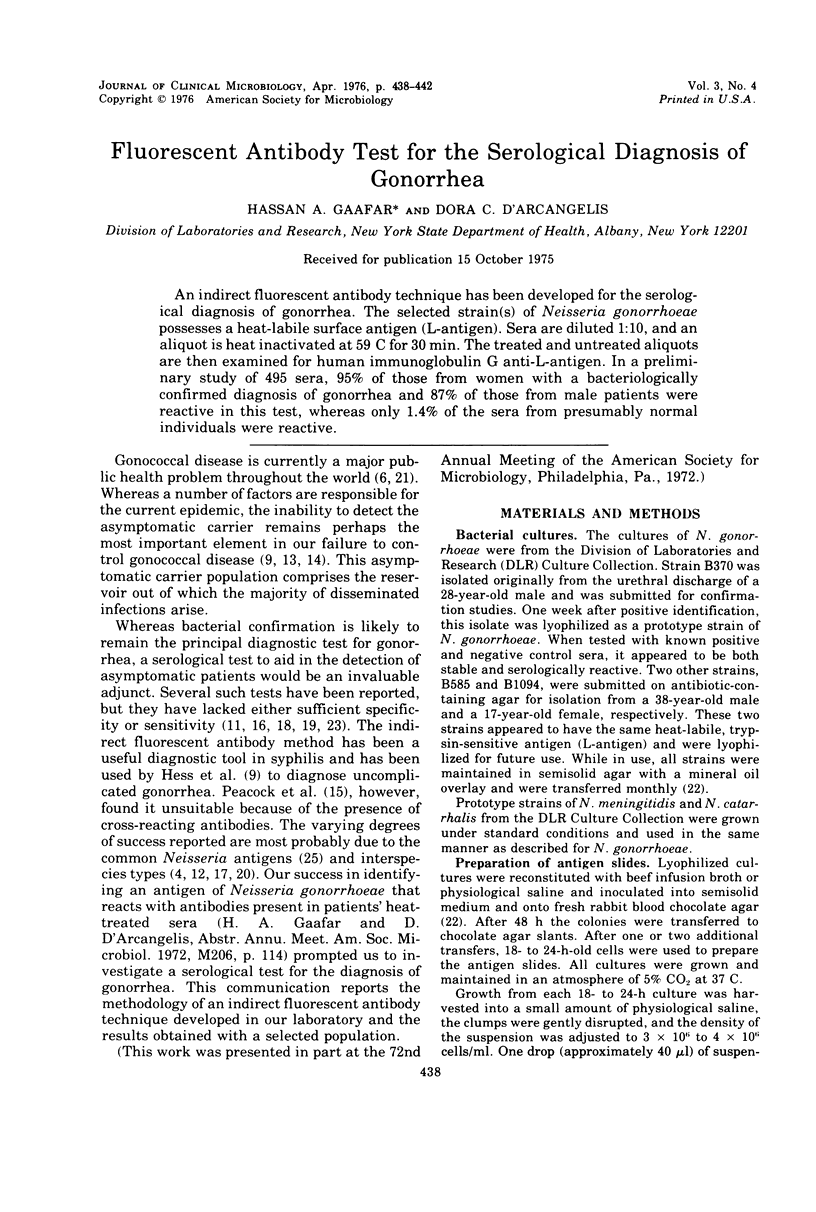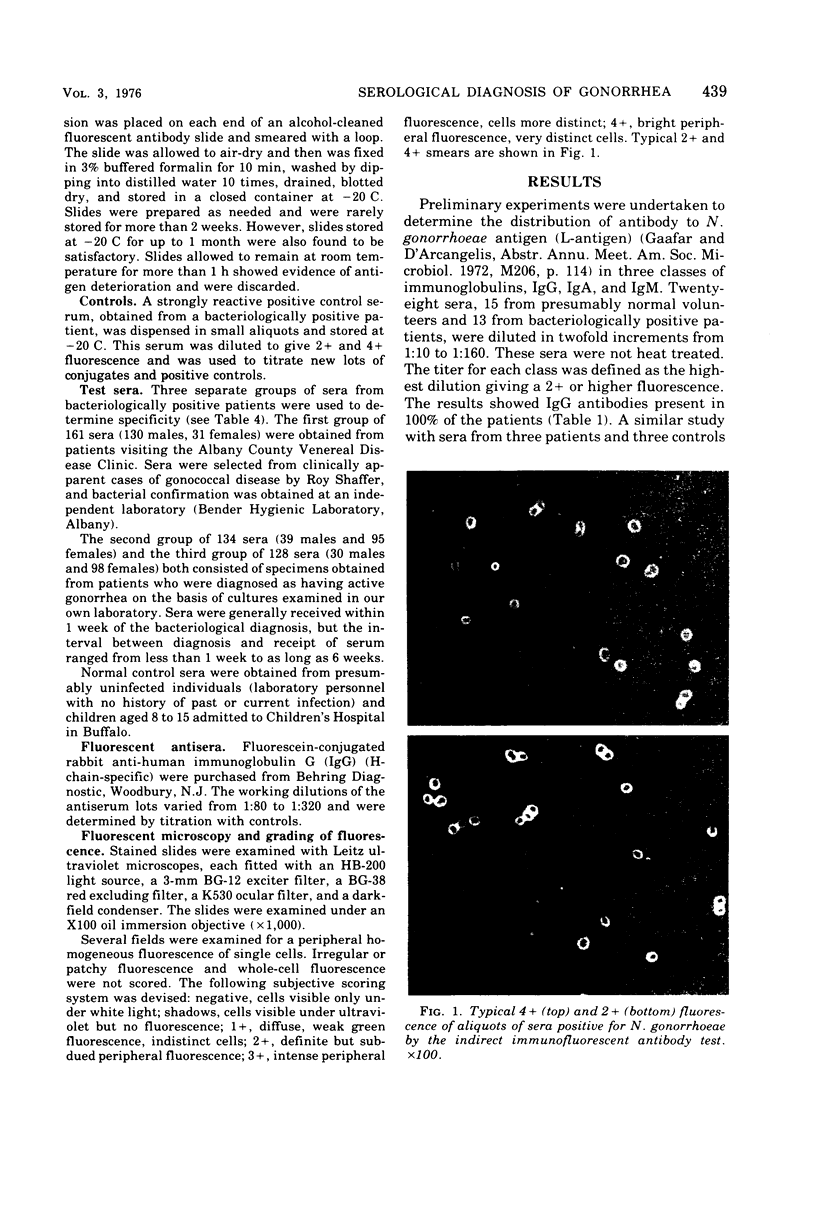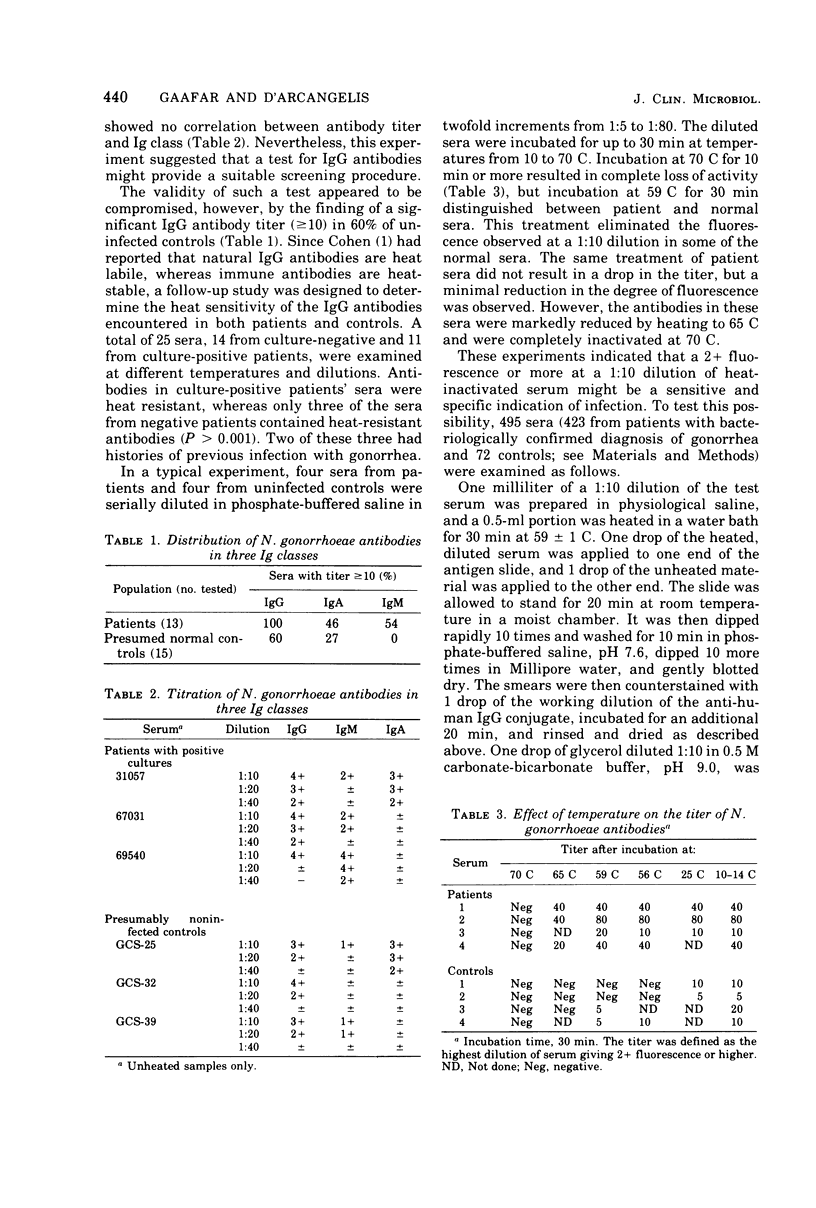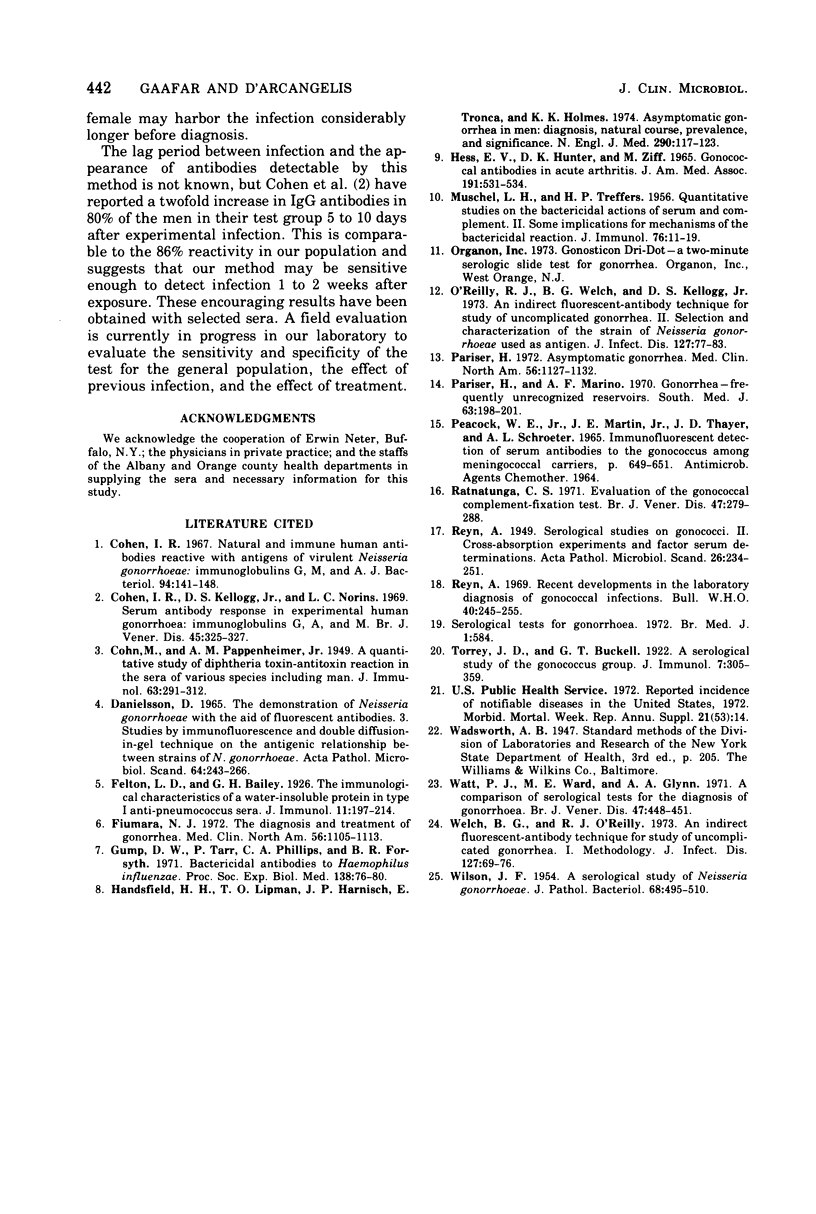Abstract
An indirect fluorescent antibody technique has been developed for the serological diagnosis of gonorrhea. The selected strain(s) of Neisseria gonorrhoeae possesses a heat-labile surface antigen (L-antigen). Sera are diluted 1:10, and an aliquot is hear inactivated at 59 C for 30 min. The treated and untreated aliquots are then examined for human immunoglobulin G anti-L-antigen. In a prelimiary study of 495 sera, 95% of those from women with a bacteriologically confirmed diagnosis of gorrhea and 87% of those from male patients were reactive in this test, whereas only 1.4% fo the sera from presumably normal individuals were reactive.
Full text
PDF




Images in this article
Selected References
These references are in PubMed. This may not be the complete list of references from this article.
- COHN M., PAPPENHEIMER A. M., Jr A quantitative study of the diphtheria toxin-antitoxin reaction in the sera of various species including man. J Immunol. 1949 Nov;63(3):291–312. [PubMed] [Google Scholar]
- Cohen I. R., Kellogg D. S., Jr, Norins L. C. Serum antibody response in experimental human gonorrhoea. Immunoglobulins G, A, and M. Br J Vener Dis. 1969 Dec;45(4):325–327. doi: 10.1136/sti.45.4.325. [DOI] [PMC free article] [PubMed] [Google Scholar]
- Cohen I. R. Natural and immune human antibodies reactive with antigens of virulent Neisseria gonorrhoeae: immunoglobulins G, M, And A. J Bacteriol. 1967 Jul;94(1):141–148. doi: 10.1128/jb.94.1.141-148.1967. [DOI] [PMC free article] [PubMed] [Google Scholar]
- DANIELSSON D. THE DEMONSTRATION OF N. GONORRHOEAE WITH THE AID OF FLUORESCENT ANTIBODIES. 3. STUDIES BY IMMUNOFLUORESCENCE AND DOUBLE DIFFUSION-IN-GEL TECHNIQUE ON THE ANTIGENIC RELATIONSHIP BETWEEN STRAINS OF N. GONORRHOEAE. Acta Pathol Microbiol Scand. 1965;64:243–266. doi: 10.1111/apm.1965.64.2.243. [DOI] [PubMed] [Google Scholar]
- Fiumara N. J. The diagnosis and treatment of gonorrhea. Med Clin North Am. 1972 Sep;56(5):1105–1113. doi: 10.1016/s0025-7125(16)32336-7. [DOI] [PubMed] [Google Scholar]
- Gump D. W., Tarr P., Phillips C. A., Forsyth B. R. Bactericidal antibodies to Hemophilus influenzae. Proc Soc Exp Biol Med. 1971 Oct;138(1):76–80. doi: 10.3181/00379727-138-35835. [DOI] [PubMed] [Google Scholar]
- HESS E. V., HUNTER D. K., ZIFF M. GONOCOCCAL ANTIBODIES IN ACUTE ARTHRITIS. JAMA. 1965 Feb 15;191:531–534. doi: 10.1001/jama.1965.03080070015004. [DOI] [PubMed] [Google Scholar]
- Handsfield H. H., Lipman T. O., Harnisch J. P., Tronca E., Holmes K. K. Asymptomatic gonorrhea in men. Diagnosis, natural course, prevalence and significance. N Engl J Med. 1974 Jan 17;290(3):117–123. doi: 10.1056/NEJM197401172900301. [DOI] [PubMed] [Google Scholar]
- MUSCHEL L. H., TREFFERS H. P. Quantitative studies on the bactericidal actions of serum and complement. II. Some implications for the mechanism of the bactericidal reaction. J Immunol. 1956 Jan;76(1):11–19. [PubMed] [Google Scholar]
- O'Reilly R. J., Welch B. G., Kellogg D. S., Jr An indirect fluorescent-antibody technique for study of uncomplicated gonorrhea. II. Selection and characterization of the strain of Neisseria gonorrhoeae used as antigen. J Infect Dis. 1973 Jan;127(1):77–83. doi: 10.1093/infdis/127.1.77. [DOI] [PubMed] [Google Scholar]
- Pariser H. Asymptomatic gonorrhea. Med Clin North Am. 1972 Sep;56(5):1127–1132. doi: 10.1016/s0025-7125(16)32338-0. [DOI] [PubMed] [Google Scholar]
- Pariser H., Marino A. F. Gonorrhea--frequently unrecognized reservoirs. South Med J. 1970 Feb;63(2):198–201. doi: 10.1097/00007611-197002000-00016. [DOI] [PubMed] [Google Scholar]
- Ratnatunga C. S. Evaluation of the gonococcal complement-fixation test. Br J Vener Dis. 1971 Aug;47(4):279–288. doi: 10.1136/sti.47.4.279. [DOI] [PMC free article] [PubMed] [Google Scholar]
- Reyn A. Recent developments in the laboratory diagnosis of gonococcal infections. Bull World Health Organ. 1969;40(2):245–255. [PMC free article] [PubMed] [Google Scholar]
- WILSON J. F. A serological study of Neisseria gonorrhoeae. J Pathol Bacteriol. 1954 Oct;68(2):495–510. doi: 10.1002/path.1700680222. [DOI] [PubMed] [Google Scholar]
- Watt P. J., Ward M. E., Glynn A. A. A comparison of serological tests for the diagnosis of gonorrhoea. Br J Vener Dis. 1971 Dec;47(6):448–451. doi: 10.1136/sti.47.6.448. [DOI] [PMC free article] [PubMed] [Google Scholar]
- Welch B. G., O'Reilly R. J. An indirect fluorescent-antibody technique for study of uncomplicated gonorrhea. I. Methodology. J Infect Dis. 1973 Jan;127(1):69–76. doi: 10.1093/infdis/127.1.69. [DOI] [PubMed] [Google Scholar]



